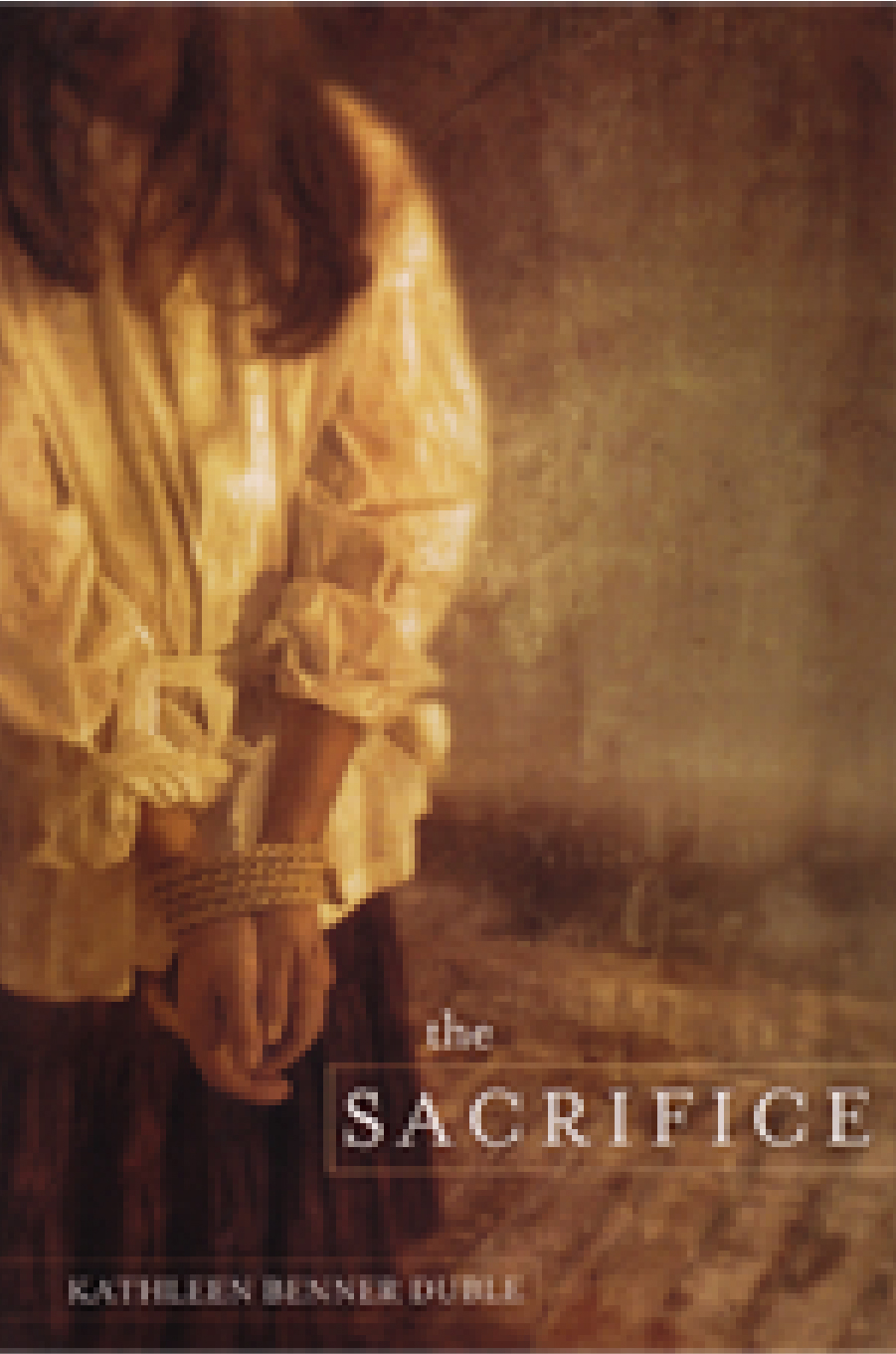

The Sacrifice
Publisher: Margaret K. McElderry
Age group: 8-13
Jacket illustration: © 2005 Kamil Vojnar.
Genre: Historical Fiction
ISBN 13: 978-0689876509
To buy this book
- Description
- Book Club Ideas
- Discussions
Description
In the year 1692, life changes forever for ten-year-old Abigail Faulkner and her family. In Salem, Massachusetts, witches have been found, and widespread fear and panic reign mere miles from Abigail’s home of Andover. When two girls are brought from Salem to identify witches in Andover, suspicion sweeps the town as well-respected members of the community are accused of witchcraft. It isn’t long before chaos consumes Andover, and the Faulkners find themselves in the center of it all when friend turns against friend, neighbor against neighbor, in a desperate fight for the truth.
At the heart of this gripping story are Abigail and her sister, Dorothy, who together must find a way to perservere during a period marked by terror, adversity and ignorance.
Told from Abigail’s point of view and based on actual events in the author’s own family history, The Sacrifice, offers a unique perspective of the Salem witch trials by delving into the devastating effects the trials had not just in Salem but throughout Massachusetts.
Booklist Top Ten Historical Fiction for Youth
2007 Nominee ALA Best Book for Young Adults
Jefferson Cup “Worthy of Note” Book
KSRC Middle School Titles – Top Pick
PSLA Top Ten (Or So) Young Adult Books
Louisiana Young Reader’s Choice Nominee
Keystone State Reading Association Young Adult Book Nominee
Booklist – Starred Review
School Library Guild Selection
Winter 2005/2006 Book Sense Children’s Picks
William Allen White Children’s Book Award Nominee
Virginia Young Readers’ Award Nominee
Nevada Young Readers’ Award Nominee
New Jersey Librarians’ Pick of the Decade
Great Stone Face Award Nominee
SSYA Nominee
Massachusetts Children’s Book Award
“What was it like to be accused during the Salem witch hunts in 1692? Duble brings the history close through the viewpoint of Abigail, 10, who is accused of working with the devil, imprisoned and tried along with her older sister. The social history is intensely dramatic: the spread of fear and hatred; the horrific conditions in the packed cell; with the accusers ‘moaning and groaning and screaming for the accused to stop tormenting them.’ But it is the story of one young girl and her family that will grab readers … The surprising climax of family sacrifice is heartrending.” – BOOKLIST – STARRED REVIEW
“How could so much evil exist in such a little town? It seems the devil has come to nearby Salem Village and several young girls are accusing neighbors of being witches, with three women already convicted. This is not the best time for ten-year-old Abigail Faulkner to have been punished in the stocks for her willful behavior, or for her father to be having fits again. Though Abigail’s grandfather, Andover’s minister, believes the girls are acting, their performances pure sport, powerful people believe them, and when the girls are called to Andover to root out witches there, the madness continues. Duble does a superb job of showing how the hysteria develops and how innocent people were trapped. She vividly evokes the horrors of the Salem Town Prison, with the cold, the lack of food and the rats sometime killing people off before trial dates ever arrived. One of the best fictional accounts for young readers about the witch trials and how good people eventually fought back.”
– KIRKUS REVIEWS
A good place to find out more about the witch trials is to visit Salem, MA. Try out this website.
Book Club ideas
FOR THE SACRIFICE :
VENUE: Have you ever been to Salem, Ma? It makes for a great trip! There is so much to do! Visit the Witch Dungeon Museum and see the re-enactment of the witch trials before heading down to the recreated prison cells. Then head up to Gallows Hill. For those of you who are too far from Salem, why not turn your home into a house from 1692? Turn off the lights. Turn down the heat. Light candles. And if you have one, make a fire. Have each reader bring the one thing they would take with him or her if they had been sent to jail and share why that thing would be important to them.
FOOD: Stews were a mainstay of life in the 1600’s. They were quick to make, hearty and could be kept warm to be eaten when you had the time. Why not start your meeting with a plate of fresh vegetables: carrots, sliced cucumbers, cherry tomatoes? All these would have grown in the garden outside Abby’s house. Then serve up a warm stew and crusty bread for the main course. Finish it all off with a nice warm apple puff. I’ve included the recipe from the 1600’s below. If you are brave enough, you can try it. Or simply make an apple crisp of your own devising.
To make Apple pufs:
Take a Pomewater or any other Apple that is not hard, or harsh in taste: mince it small with a dozen or twenty Razins of the Sunne: wet the Apples in two Egges, beat them all together with the backe of a Knife, or a Spoone. Season them with Nutmeg, Rosewater, Sugar, and Ginger: drop them into a Frying-pan with a Spoone, frye them like Egges, wring on the iuyce of an Orenge, or Lemmon, and serue them in.
ONLINE RESOURCE: http://www.witchdungeon.com/ec.html
SPECIAL GUESTS: Many people pursue the passion of digging into the past to discover their ancestors. My own father discovered Abby’s story when he began genealogical research on our family. Invite a local genealogist to your meeting and have him or her describe what is involved in tracing your family’s past.
Discussions
THE SACRIFICE
Social Studies
- What beliefs of Puritan life in 1692 do you believe we still hold on to today?
- How was Abigail’s relationship with her mother and father the same as children’s today and how was it different?
- Do you believe Abigail’s mother asking her to lie was right or wrong? Why?
- In a similar circumstance, do you believe you would have lied as Abigail did to protect yourself?
- Abigail’s world was one where conformity to the group was important – and yet she wanted to be an individual. Do you think this is still true today? Why or why not?
- What situations in today’s world reflect a lack of reason and a “mob mentality”? (e.g. riots after a sporting event) What would you do if faced with this situation?
History
- What similarities or differences do we have today from Abigail’s world of 1692 in the following:
- Trials and Evidence
- Jail Conditions
- Every day Life
- Religion
- Can you think of another situation either now or in the past, where fear has overcome reason? (e.g. the McCarthy era) What were the consequences of this?
Language Arts
- Define the following words in the novel:
a.
b.
c.
d.
e.
f.
g.
h.
i.
j.
k.
l.bodice
stocks
night watch
meetinghouse
stouthearted
looking glass
morrow
tarry
tithing man
loom
whittled
rousem.
n.
o.
p.
q.
r.
s.
t.
u.
v.
w.
x.naught
elders
wager
sport
livestock
homespun
bedcurtains
flax
shorn
churning
afflicted
magistratey.
z.
1.
2.
3.
4.
5.
6.
7.
8.
9.
10.breeches
insolence
tarry
consorting
amiss
rancid
underbed
unduly
anvil
whence
plaiting
fallow11.
12.
13.
14.
15.
16.
17.
18.
19.
20.
21.
22.impertinence
keep
rough-hewn
lousy
haggard
goodly
stench
fortnight
grub
plagued
pauper
nay - Characterization is a critical component to any good story. Can you list personality traits of the characters in the book that help define them? How is Abigail different from her sisters and brothers? How is she different from Mama? From Papa?
The Arts
- Dancing was forbidden in Puritan society, and there was little time for art or music. How do you think the lack of these arts affected the people of that time?
- If you had lived during that time, what entertainment might you have substituted or how might you have expressed yourself artistically to make up for the lack of theater, museums, TV, computer, movies etc.
Science
- Spectral evidence or “unseen” evidence was permissible during Puritan times. How would you, if you were on trial, scientifically prove that spectral evidence was unreal?
- Witchcraft was often the answer to unexplained scientific phenomena. Can you think of any examples where we have since found a scientific answer for events they may have attributed to “acts of the devil” in the past. (One example is weather)


